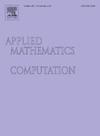强迫传播生态流行病模型中极端事件的路径:动态系统视角
IF 3.4
2区 数学
Q1 MATHEMATICS, APPLIED
引用次数: 0
摘要
我们采用季节性强迫生态流行病学捕食者-猎物模型来研究周期性传播如何影响种群动态和罕见疫情。通过分岔图、李雅普诺夫指数谱和分形维数分析支持的数值模拟,我们确定了随着强迫幅度和频率的变化,周期性、混沌和间歇性极端事件制度之间的转变。一个严格的极值框架,结合了阈值超出的广义帕累托峰值(POT)拟合和伽马分布峰间间隔(ISI)分析,证实了振幅和时间异常值都被准确捕获。结果表明,高频强迫增强了混沌不规律性,抑制了极端峰值,而低频强迫促进了零星的大振幅事件。在±20%参数扰动下的全局弹性指数表明,这些动态机制在生态不确定性下持续存在。这些发现突出了季节性在疾病驱动的生态动力学中的关键作用,并为预测和减轻罕见疫情提供了定量工具。本文章由计算机程序翻译,如有差异,请以英文原文为准。
Routes to extreme events in forced-transmission eco-epidemic model: A dynamical-systems perspective
We employ a seasonally forced eco-epidemiological predator–prey model to investigate how periodic transmission shapes population dynamics and rare outbreaks. Through numerical simulations supported by bifurcation diagrams, Lyapunov-exponent spectra, and fractal-dimension analysis, we identify transitions between periodic, chaotic, and intermittent extreme-event regimes as forcing amplitude and frequency vary. A rigorous extreme-value framework, combining Generalized Pareto Peak Over Threshold (POT) fits of threshold exceedances with Gamma-distributed Inter-Spike-Interval (ISI) analysis, confirms that both amplitude and temporal outliers are accurately captured. Results indicate that high-frequency forcing enhances chaotic irregularity while inhibiting extreme peaks, whereas low-frequency forcing promotes sporadic large-amplitude events. Global elasticity indices under ±20% parameter perturbations reveal that these dynamical regimes persist under ecological uncertainty. These findings highlight the pivotal role of seasonality in disease-driven ecological dynamics and offer quantitative tools for forecasting and mitigating rare outbreaks.
求助全文
通过发布文献求助,成功后即可免费获取论文全文。
去求助
来源期刊
CiteScore
7.90
自引率
10.00%
发文量
755
审稿时长
36 days
期刊介绍:
Applied Mathematics and Computation addresses work at the interface between applied mathematics, numerical computation, and applications of systems – oriented ideas to the physical, biological, social, and behavioral sciences, and emphasizes papers of a computational nature focusing on new algorithms, their analysis and numerical results.
In addition to presenting research papers, Applied Mathematics and Computation publishes review articles and single–topics issues.

 求助内容:
求助内容: 应助结果提醒方式:
应助结果提醒方式:


